Almost a week ago we were about to enter the region known as “Johnstone Strait” 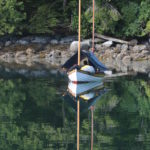 which has a reputation for nasty winds and waves. Our passage was pacific. After passing Greene Point Rapids and Whirlpool Rapids with nary a ripple in the gently ebbing current, we motored along with no wind down several channels and then passed a quiet night in Forward Harbor, anchored next to a couple who rowed in and settled down in their tiny twin-masted sailing/rowing vessel, a Drascomb. Under the blue tarp that the strung up between the two masts, they slept through a downpour rain and emerged in the morning seemingly as happy as clams. This pair, using only nature’s and their own human forces, have kept up with our dieseling device! Their plan is to row and sail wherever they can for a month before they return to their home south of Lund in the Malispina Channel (75 nautical miles behind us).
which has a reputation for nasty winds and waves. Our passage was pacific. After passing Greene Point Rapids and Whirlpool Rapids with nary a ripple in the gently ebbing current, we motored along with no wind down several channels and then passed a quiet night in Forward Harbor, anchored next to a couple who rowed in and settled down in their tiny twin-masted sailing/rowing vessel, a Drascomb. Under the blue tarp that the strung up between the two masts, they slept through a downpour rain and emerged in the morning seemingly as happy as clams. This pair, using only nature’s and their own human forces, have kept up with our dieseling device! Their plan is to row and sail wherever they can for a month before they return to their home south of Lund in the Malispina Channel (75 nautical miles behind us).
Off we go into that fearsome Johnstone Strait….. We have gone through rapids and 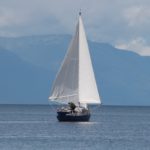 multiple passages to avoid as much of Johnstone Strait as possible, but now the rubber meets the road! The morning dawns clear sunlight illuminating vestigial clouds from the night’s storm. Light wind and down the Sunderland Passage into Johnstone Strait where the wind fills in from the east – not the feared northwesterlies. Up go the sails as we come upon another engine-less couple leading us wing-and-wing. (In the photo, note the oar they have for ’emergency’ propulsion!) Soon, off goes our motor and we sail all the way past Port Neville and on where we gybe and sail on north. We finally stop at Burial Bay on East Cracroft Island where we spend the night. In the morning we then catch the slacks and drop into Pott’s Lagoon for a couple of nights.
multiple passages to avoid as much of Johnstone Strait as possible, but now the rubber meets the road! The morning dawns clear sunlight illuminating vestigial clouds from the night’s storm. Light wind and down the Sunderland Passage into Johnstone Strait where the wind fills in from the east – not the feared northwesterlies. Up go the sails as we come upon another engine-less couple leading us wing-and-wing. (In the photo, note the oar they have for ’emergency’ propulsion!) Soon, off goes our motor and we sail all the way past Port Neville and on where we gybe and sail on north. We finally stop at Burial Bay on East Cracroft Island where we spend the night. In the morning we then catch the slacks and drop into Pott’s Lagoon for a couple of nights.
Seeing now two groups of ‘engine-less’ travelers takes us back to our son, Scott, and his experience in these waters last year at this time when he and his friend Thomas competed in the engine-less Race To Alaska. While we are finding pacific waters at this time, last year the Straits of Georgia and Johnstone Strait were churning and breaking parts of lots of little vessels. This year’s R2AK starts tomorrow!
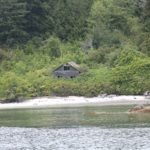 These complicated collections of small and large islands were once filled with First Nations Peoples living on the bounty of these waters in those days. White shell beaches mark long habitations. We motored by one tiny and completely failed village called Karukwees. From the water we see the white shell midden beach, and on the other side we note a barrier of thimbleberry and more bushes, and then the peak of a long- vacated Western-style home appears.
These complicated collections of small and large islands were once filled with First Nations Peoples living on the bounty of these waters in those days. White shell beaches mark long habitations. We motored by one tiny and completely failed village called Karukwees. From the water we see the white shell midden beach, and on the other side we note a barrier of thimbleberry and more bushes, and then the peak of a long- vacated Western-style home appears.
We proceeded to the village of Mamalilaculla where a midden beach shows up again and some roof peaks appear. Our cruising guides discourage us from anchoring in front, so we go a mile or so around back and anchor in what our chart calls Native Anchorage. We use our dinghy and 2 hp outboard to putt-putt us around to the village. There we find the white shell beach and a nearly impenetrable thicket of thimbleberry, Nootka rose, honeysuckle (with zillions of humming bees pollinating everywhere), and some stinging nettles. Our guide book reports that 20 years ago, First Nations individuals worked to restore this village, but now it is nearly gone. Fortunately for us, someone had hacked a bit of a passage through the bushes and vines so that we could visit an epic scale cedar log arch and a couple of homes that are well past their prime (as our photos show).
Then, on to overnight on Hanson Island, explore the woods a bit (no bears, cougars or wolves sited yet…..) and then tie up to the mooring in front of OrcaLab where we had a great afternoon with Paul Spong and his wife Helena Symonds and their summer intern, Deb. Report on OrcaLab will follow (sometime when available Internet presents itself)
Submitted from Alert Bay
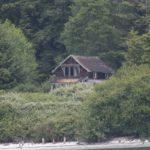
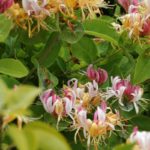
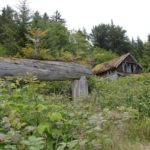
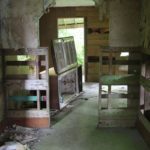
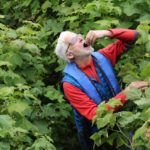
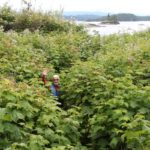
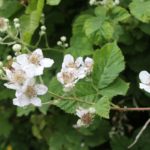
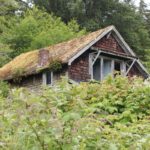

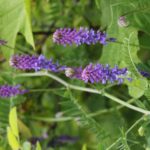
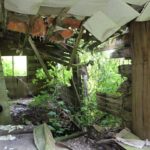
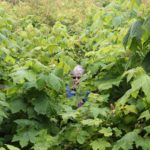
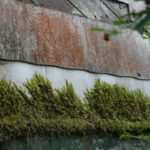
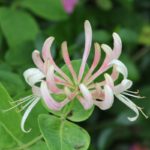


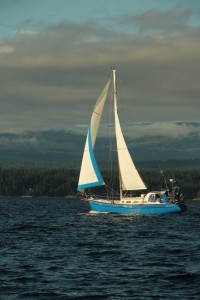
Whitten, Barbara
23 Jun 2016Glad to hear you made it across Johnstone Strait safely. I’ve been thinking about you! Have fun on the rest of your trip. Love, Barbara
Audra B. Adelberger
23 Jun 2016Yes, we heard a lot about the Race to Alaska today from people whose hero had just reached Victoria.
Glad to hear the weather gods and goddesses are so far giving you a pass.
I wonder how long that house will survive? 50 years? Relentless change..
Glad to hear from you.
Audra
Julia Robinson
23 Jun 2016This is sounding very pleasant after your Qualicum winds ordeal. And I imagine more refreshing will take place at Orcalab. We are impressed with how far you have traveled and enjoying the lovely photos.
Derrick says will you please add his email to your notice list when you get a chance: robinson@indra.com
Xoxo,
Julia
Beth carlson
25 Jun 2016The photos of flowers are stunning! We are glad to hear you have made it safely up Johnstone Strait. These little known islands, at least to me, appear to be great places for exploring! I guess there is no one to keep the native houses in good repair.
A hug to the adventurous sailors,
Beth
Eric Adelberger
26 Jun 2016as always, your photos are beautiful and powerful. I knew about abandoned first-nations villages but hadn’t realized how many abandoned European-type houses there are. It is interesting about the motorless voyagers you meet–also something I didn’t expect.
We are really enjoying hearing about your adventure.
Shirley Paterson
28 Jun 2016Thimbleberries were a favorite of ours during the summer of 1972 at Marble basecamp for Outward Bound. But they were nothing like the abundance you encountered!
Cheers,
S&C